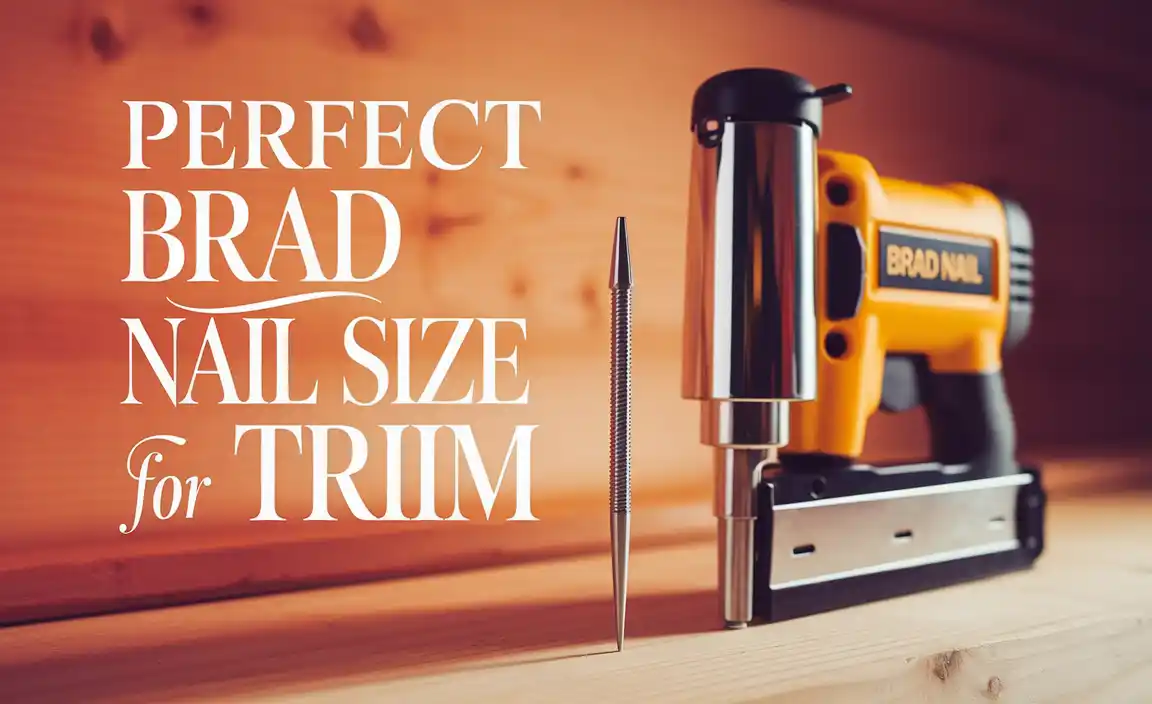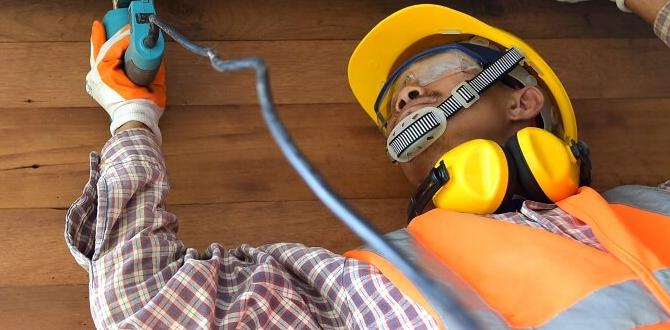For essential interior home projects like trim, molding, and paneling, a top-rated cordless brad nailer offers unmatched convenience and precision without the hassle of air hoses. Selecting the right model ensures clean finishes and faster completion of your DIY tasks, making it a valuable addition to any homeowner’s toolkit.
Tackling interior home improvement projects can feel daunting, especially when you’re aiming for that professional, polished look. Sometimes, the tools themselves can add to the confusion. Dealing with bulky air compressors and tangled hoses slows you down and can be a real pain. But what if there was a way to get those clean, precise nail placements without all that fuss? You can achieve beautiful results with the right tool. We’re here to guide you to the best cordless brad nailer, making your interior projects smoother, faster, and a whole lot more enjoyable. Get ready to transform your home with confidence!
Table of Contents
What is a Cordless Brad Nailer and Why You Need One for Interior Work
A cordless brad nailer is a battery-powered tool that drives small, thin nails called “brads” into wood. Unlike traditional pneumatic nailers, it doesn’t require an air compressor or a power cord. This means complete freedom of movement, especially crucial for detailed interior work where you’re often maneuvering around furniture, in tight corners, or on ladders.
For DIY homeowners and hobbyists, a cordless brad nailer is a game-changer for several interior tasks:
- Installing Trim and Molding: Whether it’s baseboards, crown molding, or window casings, brad nailers provide neat, consistent fastening without splitting delicate wood.
- Attaching Paneling and Wainscoting: Easily secure decorative wood panels for an elegant wall upgrade.
- Finishing Cabinetry: Perfect for adding decorative trim or assembling small cabinet components.
- Light Upholstery Projects: While not its primary use, it can be helpful for attaching fabric to wooden frames in a pinch.
- Picture Hanging and Shelving: For lighter applications, it can simplify the process of mounting items securely.
The absence of an air hose means no tripping hazards, no wrestling with tangled lines, and no noisy compressor to disturb the peace. It’s all about portability, convenience, and a clean, professional finish. This makes it an ideal tool for anyone looking to elevate their home’s interior without the complexities of pneumatic systems.
Key Features to Look For in a Cordless Brad Nailer
When you’re shopping for the best cordless brad nailer for your interior projects, several features will make a big difference. Think of these as your checklist to finding a tool that fits your needs perfectly.
1. Power Source and Battery Life
Cordless brad nailers typically run on lithium-ion batteries. Consider the voltage (18V or 20V is common) and the amp-hour (Ah) rating. A higher Ah means longer runtimes between charges. If you’re working on a big project, having a spare battery is a smart move. Some brands offer bare tools, meaning you buy the tool without a battery, assuming you already own batteries from other tools in their ecosystem. This can save money if you’re invested in a particular brand.
2. Nail Size and Depth Adjustment
Brad nailers drive nails typically ranging from 5/8 inch to 2 inches. Ensure the nailer you choose accepts the size of nails you’ll need for your projects. Depth adjustment is critical for a clean finish. A tool-free depth adjustment dial lets you easily set how deep the nail sinks into the wood. You want to be able to set it so the nail head is flush or slightly countersunk for easy filling, without damaging the surface.
3. Firing Modes: Sequential vs. Contact Actuation
Most cordless brad nailers offer at least two firing modes:
- Sequential Mode (Single Fire): You must pull the trigger for each nail fired. This is safer and allows for precise placement, essential for intricate work.
- Contact Actuation (Bump Fire): You hold down the trigger and engage the nose against the material to fire nails. This is faster for quick fastening but requires more control to avoid accidental nail placement.
Look for a tool that allows you to easily switch between these modes, giving you flexibility for different tasks.
4. Jam Clearing Mechanism
Nail jams happen, even with the best tools. A tool-free jam release is a lifesaver. It allows you to quickly and easily clear jammed nails without needing extra tools, minimizing downtime.
5. Ergonomics and Weight
You’ll be holding this tool for extended periods, so comfort is key. Look for a well-balanced tool with a comfortable grip. The weight can also be a factor, especially if you’re working overhead or in awkward positions. Lighter tools are generally easier to maneuver.
6. Capacity and Reloading
The magazine capacity refers to how many nails the tool can hold at once. A higher capacity means fewer reloads, which speeds up your work. Look for an easy-to-load magazine that clearly shows when you’re running low on nails.
7. LED Work Light
A built-in LED light is a fantastic feature, especially for interior work where lighting might be dim. It illuminates your work area, helping you see exactly where you’re placing the nail for maximum precision.
Top Cordless Brad Nailers for Interior Work: Reviews
Choosing the “best” is subjective and depends on your specific needs and budget. However, several models consistently earn high marks from DIYers and professionals alike for their performance, reliability, and features tailored for interior tasks. Here’s a look at some strong contenders in the market:
1. DeWalt 20V MAX XR Brushless Cordless Brad Nailer (DC608K)
DeWalt is a powerhouse in the tool industry, and their 20V MAX XR line is a favorite among many. This brad nailer is known for its consistent power, excellent battery life, and robust build quality. It features tool-free depth adjustment, jam clearing, and multiple firing modes for versatility.
Pros: Reliable performance, good battery life, durable construction, easy nail loading.
Cons: Can be a bit heavier than some competitors, higher price point.
2. Ryobi ONE+ 18V Cordless Brad Nailer
Ryobi offers great value, especially for homeowners. Their ONE+ cordless brad nailer is a popular choice for its affordability and solid performance for typical DIY interior projects. It’s lightweight and easy to handle, featuring dual-mode activation and convenient depth control. It’s part of the vast Ryobi ONE+ system, meaning if you have other Ryobi 18V tools, the batteries are interchangeable.
Pros: Excellent value, lightweight and ergonomic, compatible with a wide battery system.
Cons: May lack the consistent power for very dense hardwoods compared to higher-end models.
3. Milwaukee M12 FUEL Brushless Cordless Brad Nailer
Milwaukee’s M12 FUEL line is designed for compact power. This brad nailer is incredibly lightweight and maneuverable, making it ideal for extended use and tight spaces. The “FUEL” designation means it uses a powerful (and efficient) brushless motor. It provides excellent control and consistent drives, with easy depth adjustment and quick-access jam clearing.
Pros: Extremely compact and lightweight, powerful for its size, excellent battery efficiency.
Cons: Limited nail length capacity (typically up to 1-1/2”), higher cost.
4. Bostitch 18V Cordless Brad Nailer (BT8010-2)
Bostitch is a name synonymous with nailers. Their 18V cordless brad nailer is designed for performance and reliability. It offers strong power to drive nails consistently, even into slightly tougher materials. Features include tool-free depth adjustment, a jam release lever, and dual firing modes. It’s a solid workhorse for various interior trim jobs.
Pros: Strong driving power, reliable performance, good ergonomics.
Cons: Battery system might be less common than DeWalt or Ryobi for some users.
5. Metabo HPT 18V Cordless Brad Nailer (Model NT1855DM)
Metabo HPT (formerly Hitachi Power Tools) offers a compelling option with their 18V cordless brad nailer. It’s praised for its consistent fire rate and ability to drive nails flush into various woods. It features a tool-less depth adjustment, a clear view of the magazine, and a comfortable grip. The battery platform is also part of their extensive 18V line.
Pros: Consistent firing, good depth control, clear magazine view for monitoring nail levels.
Cons: Can be slightly heavier than some ultra-compact options.
How to Choose the Right Cordless Brad Nailer for Your Projects
The “best” nailer is the one that perfectly matches your needs. Here’s a simple guide to help you make the right choice:
Assess Your Typical Projects
What will you be doing most often? Installing delicate window trim? Heavy baseboards? If you’re working with softer woods or smaller trim pieces, a lighter, more maneuverable tool might be ideal. For larger baseboards or harder woods, you’ll want a nailer with ample power.
Consider the length of brads you’ll use:
- 3/4″ to 1-1/4″: Good for delicate trim, craft projects, speaker boxes.
- 1-1/4″ to 1-3/4″: Versatile, suitable for most interior trim, window casing, door jams.
- 1-3/4″ to 2″: Needed for thicker baseboards, chair rails, or when extra holding power is required.
Budget Considerations
Cordless brad nailers range from around $100 to $300 or more. Ryobi often offers budget-friendly options that are great for homeowners. DeWalt, Milwaukee, and Metabo HPT tend to be in the mid to higher price range, offering more advanced features and durability for heavy use. Don’t forget to factor in the cost of batteries and a charger if they aren’t included.
Battery System Compatibility
If you already own tools from a specific brand (like DeWalt, Milwaukee, Ryobi, or Makita), it’s often economical to buy a nailer from the same brand. This allows you to use your existing batteries and chargers, significantly reducing the overall cost and simplifying your toolkit.
Weight and Ergonomics
This is crucial for comfort, especially during longer projects. If you find a tool too heavy or difficult to grip, it will make your work less enjoyable and potentially less accurate. Whenever possible, try to hold the nailer in a store to get a feel for its weight and balance.
Brand Reputation and Reviews
Read reviews from other DIYers and professionals. Look for consistent feedback on reliability, ease of use, and performance. Reputable brands often have better customer support and warranty services.
Comparative Table of Popular Models
Here’s a quick comparison to help you visualize the differences between some top picks. Note that specifications can vary slightly by exact model number.
| Feature | DeWalt 20V MAX XR | Ryobi ONE+ 18V | Milwaukee M12 FUEL | Bostitch 18V | Metabo HPT 18V |
|---|---|---|---|---|---|
| Typical Nail Size (in) | 5/8 – 2 | 5/8 – 2 | 5/8 – 1-1/2 | 5/8 – 2 | 5/8 – 2 |
| Weight (w/ Battery) | ~6-7 lbs | ~5-6 lbs | ~3-4 lbs | ~6-7 lbs | ~6-7 lbs |
| Battery System | 20V MAX | 18V ONE+ | M12 | 18V | 18V |
| Brushless Motor | Yes | No (typically for entry-level) | Yes (FUEL) | Yes | Yes |
| Key Strength | Power & Durability | Value & Versatility | Compactness & Ergonomics | Consistent Performance | Reliability & Power |
| Price Range (Tool Only) | $$$ | $ | $$$ | $$ | $$ |
Note: Price ranges are relative: $ = budget-friendly, $$ = mid-range, $$$ = premium. Weights are approximate and can vary based on battery size. Always check the latest specifications for the exact model you are considering.
Getting Started with Your Cordless Brad Nailer: A Step-by-Step Guide
Once you’ve chosen your cordless brad nailer, it’s time to put it to work! Here’s a simple, step-by-step guide to get you started on your interior projects.
Step 1: Read Your Manual
This might sound basic, but every tool is slightly different. Take a few minutes to read the manufacturer’s manual. Pay attention to safety warnings, battery charging instructions, and specific operating procedures for your model. You can often find these manuals online if you’ve lost yours. Reading material from reliable sources like the Occupational Safety and Health Administration (OSHA) on safe tool operation is also highly recommended for general power tool safety.
Step 2: Charge the Battery
Ensure your lithium-ion battery is fully charged before you begin. Most chargers have indicator lights that show when the battery is ready. A dead battery mid-project is frustrating, so start with a full charge.
Step 3: Load the Nails
Open the magazine door. Most nailers have a spring-loaded follower. Pull the follower back and insert a strip of brad nails of the correct size and angle required by your nailer. Ensure the nails are seated correctly against the magazine wall and that the follower is released to hold them in place. Your manual will show the correct angle (usually 15, 20, or 30 degrees).
Step 4: Set the Depth Adjustment
Before you fire your first nail, it’s crucial to set the depth of drive. Locate the depth adjustment mechanism, usually a dial or wheel near the nose of the tool. Start with a medium setting.
Test Drive: Find a scrap piece of the same material you’ll be working with. Place the nailer against the scrap wood and fire a nail. Check the result:
- Nail is too deep (sunk in): Reduce the depth setting (turn the dial counter-clockwise).
- Nail is too shallow (sticking out): Increase the depth setting (turn the dial clockwise).
- Goal: The nail head should be flush with or slightly below the surface, allowing it to be easily covered with wood filler or mud without creating a bump.
Repeat this until you achieve the desired depth for all your nails.
Step 5: Select Firing Mode
Switch to the appropriate firing mode. For precise placement, like near the edge of trim, use Sequential Mode (Single Fire). For faster work on longer pieces where precision is less critical, you might switch to Contact Actuation (Bump Fire), but always engage the safety contact before pulling the trigger in this mode.
Step 6: Position the Nailer
Hold the nailer firmly against the workpiece. Ensure the nose of the nailer is flat against the surface. If using Contact Actuation, press the safety contact tip firmly against the wood first, then pull the trigger.





